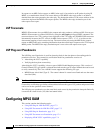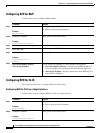
CHAPTER
18-1
Cisco ASR 901 Series Aggregation Services Router Software Configuration Guide
OL-23826-09
18
Configuring Routing Protocols
In addition to static routing, the Cisco ASR 901 supports the following routing protocols:
• OSPF—An Interior Gateway Protocol (IGP) designed for IP networks that supports IP subnetting
and tagging of externally derived routing information. OSPF also allows packet authentication and
uses IP multicast when sending and receiving packets. For more information on how to configure
OSPF, see the IP Routing: OSPF Configuration Guide, Cisco IOS Release 15.1S.
• IS-IS—An Open System Interconnection (OSI) protocol that specifies how routers communicate
with routers in different domains. For more information on how to configure IS–IS, see the IP
Routing: ISIS Configuration Guide, Cisco IOS Release 15.1S.
• BGP—An interdomain routing protocol designed to provide loop-free routing between separate
routing domains that contain independent routing policies (autonomous systems). For more
information on how to configure BGP, see the IP Routing: BGP Configuration Guide, Cisco IOS
Release 15.1S.
For information about Bidirectional Forwarding Detection (BFD) including sample routing
configurations with BFD, see Configuring BFD.
Note Cisco ASR 901 router supports IP routing on SVI interfaces.
Note Cisco ASR 901 router does not support IGP fast timers.
Note The maximum number of prefixes supported in Cisco ASR 901 router is 12000.
Note The maximum number of SVI's supported in Cisco ASR 901 router is 250.
Changing Default Hashing Algorithm for ECMP
The hashing algorithm for ECMP is changed from Cisco IOS Release 15.3(2)S onwards. You can use
the following commands to configure various types of ECMP hash configurations for improved load
distribution of IP traffic.
• asr901-ecmp-hash-config global-type


















